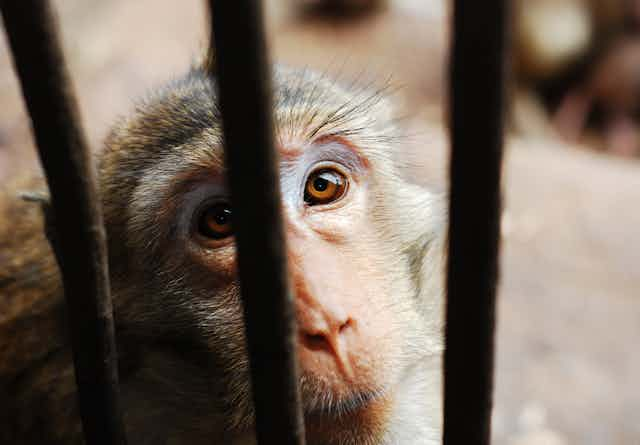Let’s picture what our societies might look like if animals were granted rights against being killed, made to suffer or exploited for human gain.
When activists argue for animal rights, they ask us to imagine a different world. First, we need to understand how our lives are shaped by animals’ lack of rights.
The range of uses we put animals to is enormous – going far beyond food, labour and clothing. We use gelatin to treat paper, from loo-roll to watercolour paper. Tallow finds its way into our banknotes, animal hair gives structure to suits and milk protein is found in condoms and any number of tablets. Beeswax and shellac (manufactured by crushing countless lac beetles) are used to make sweets shiny and treat wood.
We even use waste from animal carcasses as biofuel.
Many religious and national festivals involve consuming meat or wearing costumes made from animal parts. Animal products are everywhere. We kill billions of animals to make them every year.
A call for animal rights is a call to forbid most of these uses in law. It is also a call to reconfigure our relationships with animals. Imagining such possibilities can be difficult. What’s the point, we may wonder, of even considering the ethics of a future we can barely imagine?
Thinking about it
One of the roles of philosophers working on animal ethics, I think, is to help us imagine. The humanities and social sciences try to answer the question “so how would that work?”. That makes ethical possibilities, even unlikely ones, the subject of meaningful consideration.
The first thing to say is that although granting animals rights would dramatically change how we manufacture products, many of us may not even notice. Not only are vegan alternatives available for most animal products, but advances in technology make the use of animals possible without killing them or making them suffer.
It is already possible to grow meat, eggs, milk, and leather in a lab without harming animals.
In the future, scientific advances will probably make widescale production possible.
One change we might notice though, would be an improvement to our environment. Animal agriculture uses vast amounts of land, water and energy, both to house and feed animals, and pollutes our air, rivers and oceans.

One worry we might have is about the loss of jobs and income generated by animal agriculture. The sector is worth billions of pounds.
Animal rights theorists might respond in a number of ways: one would be to say that we ought not to protect jobs and income generated from rights violations. Another response might be to point to the fact that intensive animal agriculture largely depends on terrible working conditions, often suffered by marginalised groups of people.
Animal testing
Similarly, most of us probably wouldn’t notice a ban on the use of animals in most forms of scientific research. New forms of animal-free modelling are now constantly being developed and many are well established. For example, advances in computer modelling allow scientists to predict how medicines will act in human patients without the need for testing on other animals.
Many people worry that we might not have achieved many of the medical advances we have without animal testing. This may well be true, but for animal rights advocates this isn’t enough on its own to justify it.
A core purpose of a right is to protect the rights-bearer from being used as a means to benefit someone else. We can probably think of a great many deeply unethical practices that could benefit lots of people, but we rule them out because they would violate moral principles. In any case, if future advances are possible without harming nonhuman animals, then we ought to opt for alternative methods of research.
What about the uses we find for live animals, for example as workers, entertainers and companions? Even though many people love their pets as if they were family, there are some people who ask vets to have their pets killed because they no longer want them. Indeed, such cases are common enough that the veterinary profession has coined the term “convenience euthanasia”. In these cases, vets do have the right to refuse to euthanise an animal. But there is ultimately no law to prevent vets from carrying out these instructions and many struggle with the ethics of doing so.
Read more: Why your veterinarian may refuse to euthanise your pet
Animal rights
If companion animals had rights, then they would have to be treated differently. One possibility is that pets would become something much closer to a fostered family member. We might even start to think of nonhuman animals as fellow citizens. As citizens, animals could be entitled to workers’ rights, health and retirement benefits.
When the police dog Finn was stabbed by a robbery suspect in 2016 in Stevenage, England, the judge trying the case found that all he could charge the defendant with was property damage.
Although Finn’s case did result in the law being changed to prevent harm to service animals being justified as self-defence, it didn’t substantially change the status of nonhuman animals in law.
Full animal rights mean that dogs like Finn would be entitled what is known as legal personhood. In some parts of the world, such as in the case of the river Magpie in Canada, there are already mechanisms like this for natural entities.
Once, people probably couldn’t imagine a future where slavery was made illegal, or laughed at giving every adult in society a vote. I suspect that one day we will look back on the way we have treated nonhuman animals with a similar sense of disbelief.
When we try to imagine a world with animal rights, it turns out not to be so difficult after all. The concepts, technologies, and mechanisms needed are already in place, we just need to be brave enough to use them.

